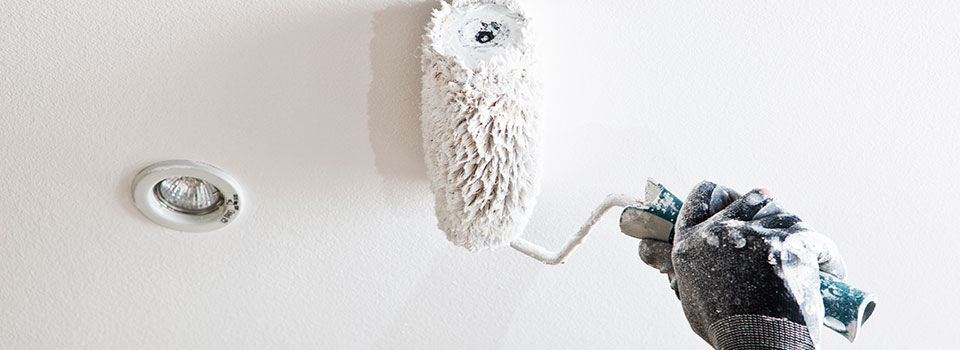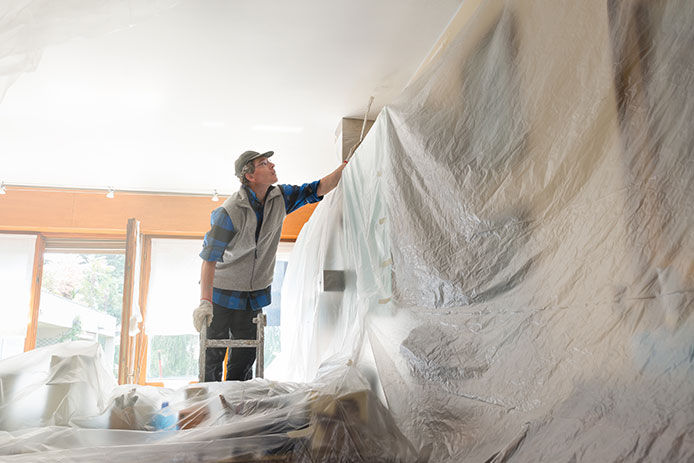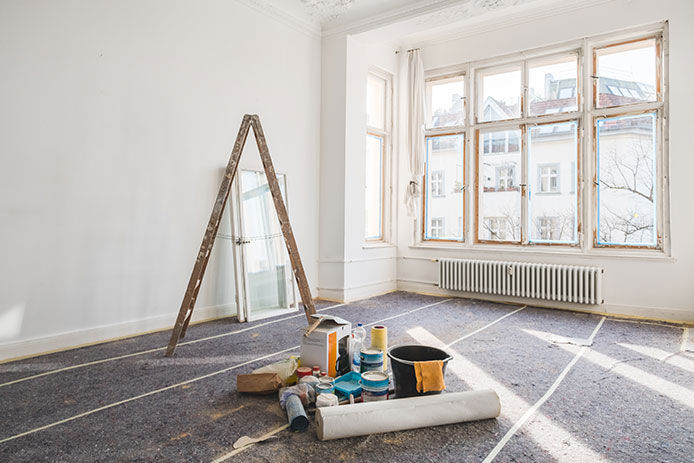How to Paint a Ceiling

The ceiling may attract fewer glances than the walls of a room, but it also accumulates a lot of dust, smoke, and stains over the years. Eventually, this surface needs painting as much as any other part of the room. Most homeowners don’t paint their ceilings every time they refresh their walls because the process of painting over your head can be a workout. But with these tips, it’s easy to quickly and efficiently paint your ceiling for a quick update to any room.
Preparing the Ceiling to Look Its Best

It’s best to paint the ceiling before the walls. If any paint runs down the edges or drips onto the walls, it’s easy enough to cover up when painting the walls second. Most ceilings will need a little sanding and may need some patching if there is any damage or holes. Use a sanding pole tool with a sheet of 100-grit general-purpose sandpaper attached to it. Run the sandpaper over the ceiling to smooth bumps and paint flakes on the surface, focusing on areas that are peeling or uneven. After sanding, wipe the ceiling with a damp sponge to remove dust. Make sure to apply primer before painting since paint needs extra grip to adhere smoothly to a horizontal surface.
Before applying any paint, move out any furnishings and decorations you can to reduce the chance of drips. Anything that has to stay in place must be covered with painter’s plastic or drop cloths to keep them clean.
Choosing a Finish and Color

Ceilings are often painted white for a light-reflecting surface that helps brighten up the space. However, there are plenty of options for more colorful ceiling ideas that liven up the room. Lighter-colored ceilings make the room seem taller and larger, while darker ceilings help bring the ceiling down visually. Stick to a color only a few shades darker than the wall, while lighter colors can run to white. Make sure to use a color wheel to choose a complementary rather than contrasting shade for a cohesive look.
For the finish, stick to the matte side of the spectrum with flat or eggshell paint. Glossy ceilings are not generally recommended because they reflect too much light, making the room busy and visually distracting. Dark ceiling colors and low ceilings may need a satin coating to help bring more light into the room.
Investing in Some Extra Painting Supplies

You can use most of the same paint trays, rollers, and drop cloths you’d use for any other wall painting chore. However, there are a handful of tools you’ll want for this task in particular:
- An extending sanding block, as mentioned above
- A telescoping handle for your paint roller
- Painter’s plastic and tape to cover all the walls, the floor, and any furnishings
- Cutting or edging tools that you prefer, from angled brushes to specialty rollers
- A medium to low nap roller to reduce drips and splatter during ceiling painting
- A step stool or short ladder gives you better access to higher ceilings.
Deciding When to Paint a Ceiling

You don’t have to wait until a ceiling is noticeably stained or faded to paint it. Applying a fresh coat of paint every time you refresh the walls may seem like a lot of extra work, but it’s the best practice to give the room a cohesive look. At the very least, commit to painting the ceiling with a fresh coat every other time the walls are painted. There’s nothing wrong with just painting the ceiling even when the walls don’t need it yet if you’re willing to do some extra work taping up plastic.
Following the Basic Steps
There are only a few basic steps to painting a ceiling.
- Tape up the painter’s plastic so it drapes over the walls. Place the tape along the upper edge of the wall trim, aligning the tape carefully to create a crisp edge. Spread plastic over the floor and furniture as well.
- Starting with the primer, cut in with a tapered brush or specialty tool around the taped edges.
- Roll on a layer of primer across the middle of the ceiling, working from the painted edges inward.
- Let the primer dry.
- Cut in with a brush and the interior paint following the same process as before.
- Roll on the first coat of paint.
- Let it dry, then repeat for a second layer. Apply a third coat if needed, especially on textured ceilings.
Dealing with Textured Ceilings

There are two options for coating a textured ceiling with popcorn or a lace pattern on it. The first is to use a thick nap roller and prepare for extra drips by covering every square inch with plastic. The alternative is to rent a paint sprayer, which generally requires the same amount of plastic coverage but provides faster results and more even application. It’s best to rent or buy a sprayer when you’re already planning to paint your entire house or at least the walls along with the ceiling. Even so, paint spraying requires practice, so set up some boards in the backyard before tackling a ceiling project.
Due to gravity, there will likely be at least a few drips during the painting process. Keep a damp sponge or paint thinner and rags on hand for quick cleanup as needed. Holding the roller above your head can wear your arms out, so consider getting a helper to take over when you need a break so the paint can go on smoothly without patchiness.
While do-it-yourself projects can be fun and fulfilling, there is always a potential for personal injury or property damage. We strongly suggest that any project beyond your abilities be left to licensed professionals such as electricians, plumbers, and carpenters. Any action you take upon the information on this website is strictly at your own risk, and we assume no responsibility or liability for the contents of this article.